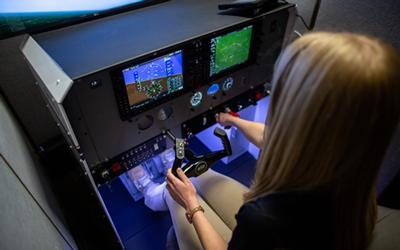Increases High-Tech Training Opportunities For Student Pilots
Liberty University School of Aeronautics is committed to using state-of-the-art technologies to reduce training costs while delivering a high-quality experience. Recently, Liberty acquired three Frasca Reconfigurable Training Devices to bolster its flight simulator fleet. Liberty is one of only a handful of institutions nationwide to have FAA National Simulator Program certification.

RTDs are the first high-fidelity flight simulation devices to incorporate Garmin G1000 software without requiring expensive aircraft hardware. RTDs are also reconfigurable for multiple types of aircraft. Their smaller size and lower cost are ideal for a growing program like Liberty’s.
“These devices allow us to specifically work on instrument training and procedures in the classes that really take a lot of practice for the student to get down well,” explained Kevin Martin, Liberty SOA associate director of flight training. “With the industry where it’s at — where we need more pilots than we can produce — we need to train faster and do it more economically.”
Liberty’s residential aeronautics program has grown from 20 to 460 students since 2002. More than 2,000 students are taking aviation courses online.
Martin said Frasca International, manufacturer of the new simulators, has developed some of the best flight simulator devices in the world. The company has been a key partner with Liberty since 2012, working with LU staff to produce new technology that helps better meet the needs of education programs.
“We are able to kind of shape where some of their products are going,” Martin said. “Our relationship has allowed us to provide valuable information that aided in design features of the new RTDs.”

He said other flight training programs are looking to Liberty and its simulator fleet as a standard of excellence.
In addition to the RTDs, students also train on four large simulators that are certified as Level 5 by the FAA and use satellite overlay visual mapping on high-definition wraparound screens with laser projection to give students more accurate visuals.
“An airplane is not always the best classroom,” Martin said. “There’s all sorts of stuff going on in there; it is really hard to concentrate. In the sim, instructors can control the environment. They can pause what the student is doing and go over a concept that they are struggling with which means the students can have the repetition that is needed to help them succeed.”
Michael Kopp, a junior in Liberty’s commercial/corporate program, said the simulators are “such a blessing.”
“You save a lot of money, save a lot of time,” he said. “You can’t pause in the aircraft. In the sim, you can redo a procedure and rewind on an approach to recapture it or redo a maneuver if it’s not within standard. You can spend the extra time to see how the systems work, which definitely helps when you are up in the aircraft.”
With the simulator training, students feel more prepared when they enter the cockpit.
“Going in the sim allowed me to build my confidence in the procedures and the checklist usage so that when I got to the plane I was more confident,” said Certified Flight Instructor Erika Jordan, who graduated last May from the commercial/corporate program. “It’s also a lot cheaper so you can build up some of your skills without having to pay as much for the plane to get hands-on training.”
(Images provided with Liberty University news release)
 ANN's Daily Aero-Term (04.24.24): Runway Lead-in Light System
ANN's Daily Aero-Term (04.24.24): Runway Lead-in Light System ANN's Daily Aero-Linx (04.24.24)
ANN's Daily Aero-Linx (04.24.24) Aero-FAQ: Dave Juwel's Aviation Marketing Stories -- ITBOA BNITBOB
Aero-FAQ: Dave Juwel's Aviation Marketing Stories -- ITBOA BNITBOB Classic Aero-TV: Best Seat in The House -- 'Inside' The AeroShell Aerobatic Team
Classic Aero-TV: Best Seat in The House -- 'Inside' The AeroShell Aerobatic Team Airborne Affordable Flyers 04.18.24: CarbonCub UL, Fisher, Affordable Flyer Expo
Airborne Affordable Flyers 04.18.24: CarbonCub UL, Fisher, Affordable Flyer Expo




